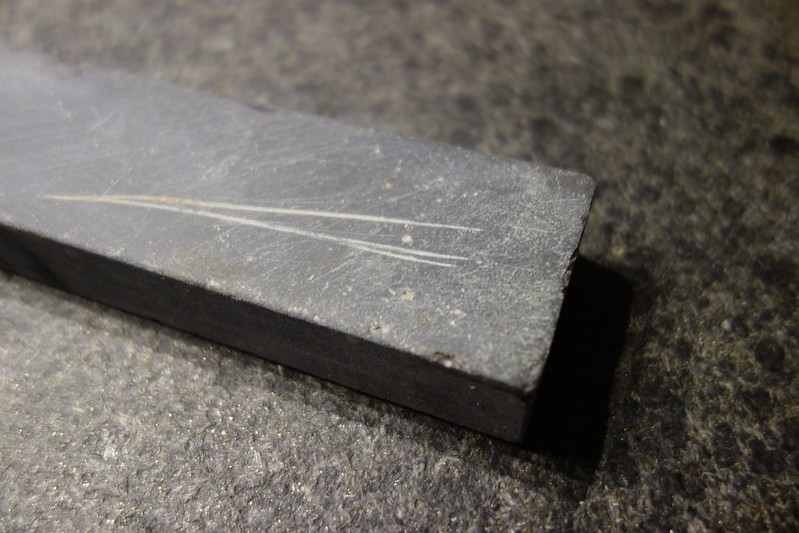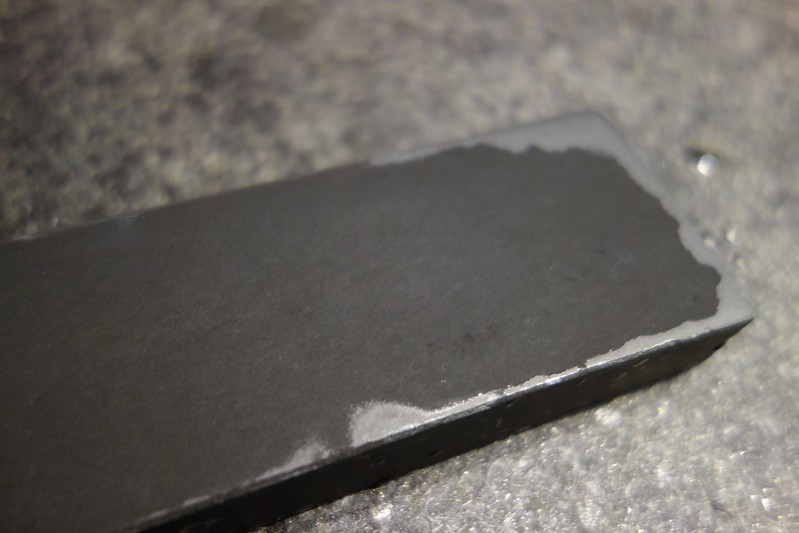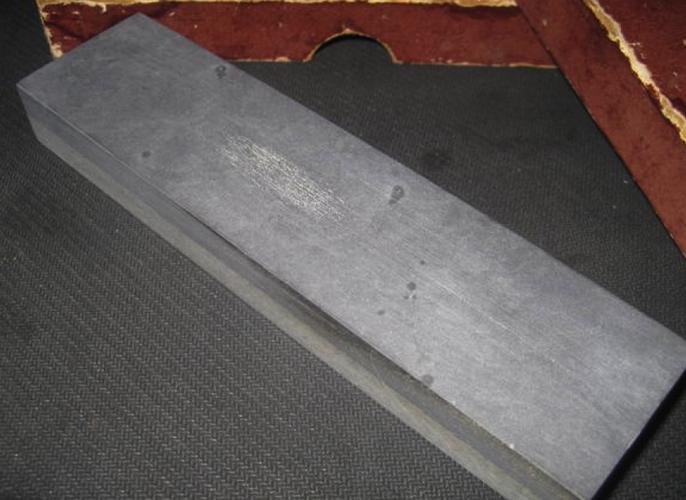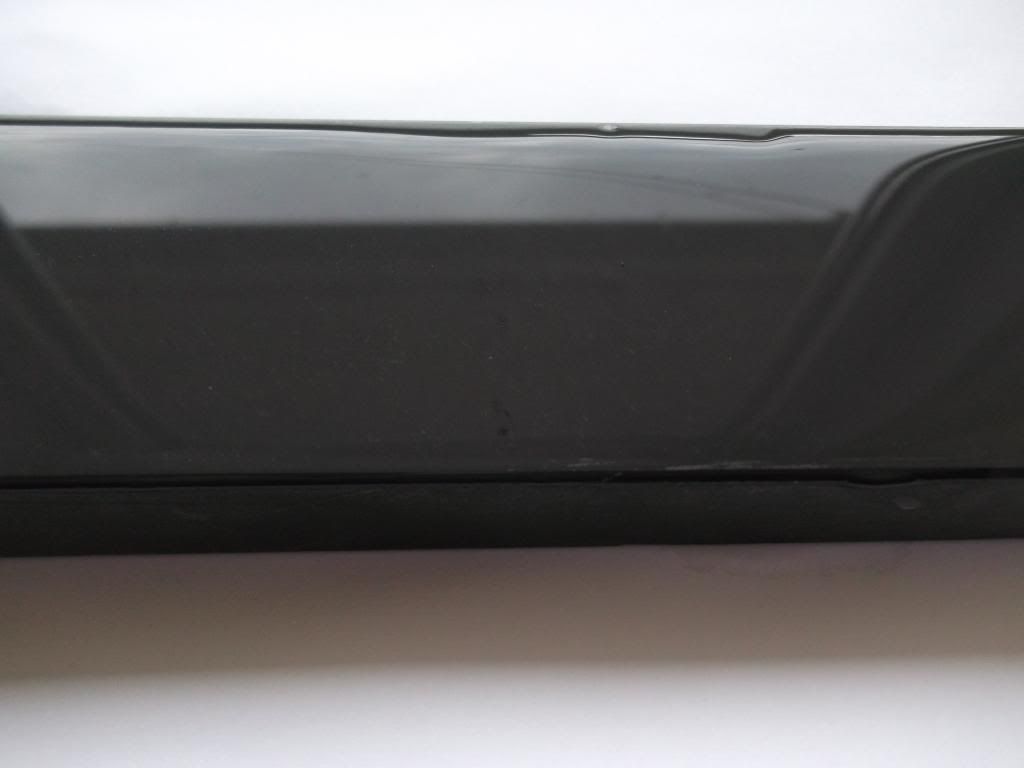Results 1 to 10 of 24
Thread: Unknown stone. ID please.
Hybrid View
-
04-11-2014, 09:35 AM #1

Reminds me a bit on the Silkstone i have...talking about black and grey slates its really difficult to differ because there are several
stones around (Dragons Tongue, Yellow Lake, Silkstone, etc...).....
Yellow Lake before lapped:

Silkstone lapped (has fine silk like layers, when surface is wet):
http://straightrazorpalace.com/hones...ats-story.html

Last edited by doorsch; 04-11-2014 at 09:37 AM.
-
04-11-2014, 11:10 AM #2Senior Member



- Join Date
- Apr 2008
- Location
- Essex, UK
- Posts
- 3,816
Thanked: 3164
Don't make the mistake that Llyn Melynllyn (Welsh for Yellow Lake) is a particular variety of hone slate. In early years it may well be that just the honing slates in the immediate vicinity of Llyn Melynllyn were quarried, but 'Yellow Lake' soon acquired brand name status and encompassed a number of slates all from different quarries all sold under the Yellow Lake trademark with no distinction as to origin or performance. That means you cannot even standardise within the confines of a single brand (rather than 'type') of hone. A friend reckons that the stones could have been quarried at four different sites. Early stones seem to have been packed in a box provided by A B Salmen, a london company started in 1850 by Samuel Salmen of Mile End for his son Albert Berl Salmen that provided all sorts of english, welsh and german hones as well as coticules and the like - they were active in the late 1800s at Houndsditch, London, then at Aldgate (executors). A listing of mines from 1908 shows the Llyn Melynllyn owned by the executors of A B Salmen, Mr Salmen having died, evidently. In 1926 we find that the firm has changed name again. It was A B Salmen Ltd, but a resolution was passed in September 1926 to voluntary wind-up the company and appoint Mr E G Bygrave chartered accountant of Wardour Street, London, as the liquidator. The firm was sold to A. Bernstein. A little later the firm emerges in a new guise - The Successors of A B Salmen Ltd - having been bought by Mr R. Waxman and they were active until the late 1980s, running the business from Highgate Hill in London.
The earlier (1890s) advertisements show that A B Salmen's themselves were the successors to S. Samuel. The earlier firm also seems to have been a stone quarrier and importer and furnisher of carpenters bags, etc. On the reverse of an 1890 advert it says "Importer & quarrier. Hones, oilstones, grindstones, scythestones &c, carpenters tool & hand basket importer. Office 1 Castle St. Houndsditch. E.C. Steam works, Salmen St. South Grove, Mile End, London. E. ... [On the reverse] Turkey oilstones, Arkansa ... Water of Ayr stone, Ragstones, Scythe stones, Devon batts, Indian pond stones. Yellow Lake hones, German ... Blue & grey stone slips, Gold testing stones, Clearing stones and curriers' blocks, Turkey, Arkansa & Putty powder, Holy stones, Circular stones, all kinds. Bilston, Blue grit, Newcastle, Yorkshire and other grindstones, also mounted in Iron and Wooden troughs. Importers of tool and painters' baskets".
A B Salmen was well respected among the jewish community of Hackney. Not only was a street named after him, but in 1884 he was elected Warden of Hackney Synagogue and held the post without interruption for 22 years. He died in October 1907, hence the use of 'Exors' (meaning executors) preceeding the company name in 1908. The 1891 Census shows him as being aged 37 and his profession as 'oil stone merchant'.
Albert Berl Salmen's father, Samuel Salomen (changed to Salmen) was born in Prussia in 1818 and the UK 1871 Census shows his occupation as 'stone merchant'.
The boxes underwent a number of changes. Some say that the hones are Genuine Yellow Lake Oilstones, registered & Supplied Direct by the Quarrier. These - the yellow coloured packets anyway - have no mention of A B Salmen on them. However, Salmen's were noted for supplying all sorts of scythe stones, hone stones and masons/carpenters toolbags, and a picture of these things appears on the label just as they do in some of Salmen's other advertising material. Other packets have Salmens name on them, and there are red, yellow and blue varieties and perhaps one other, but I forget....
Most of the hones appear greyish in colour, the actual purple ones being in the minority, and the grit equivalent of these varies between 6k and somewhere below 10k for the most part. However there is one other type that differs in colour and composition - it is almost black (or a very, very dark grey) and instead of being a siliceous slate it is a calcareous siltstone and gives results much like a Silkstone, superior to the rest of the Yellow Lake family of honing slates. The grit equivalent of one of these would be in the region of 11k or so.
The Silkstone is a mystery in itself. It comes in a buff coloured wrapper mostly, although smaller sizes were issued in tins and some were even distributed to the armed forces. The card sleeve has "Silkstone, Razor Hone and Whetting Stone, to be used with oil or water" on it and along another side it has "A Cambrock Product" which implies that 'Cambrock' is a company name, but UK Companies House has no record of it ever having been registered. That makes me think it is a combination of two words - 'cambrian' and 'rock', cambrian directing us back to Wales as a source for the Quarry.
Regards,
Neil
-
-
04-11-2014, 12:05 PM #3Junior Member

- Join Date
- Apr 2014
- Posts
- 10
Thanked: 1
doorsch
You can't tell from my pics but the stone has small black specks and a hard to see pattern similar to your pics.
I wish I had a better camera and the sill to use it.
-
04-11-2014, 12:33 PM #4Senior Member



- Join Date
- Apr 2008
- Location
- Essex, UK
- Posts
- 3,816
Thanked: 3164
Lexx - are the black specks well defined as in this pic of a Water of Ayr-

There is sometimes a very thin line connecting the spots, sometimes not. They tend to be larger than 'specks' however.
Regards,
Neil
-
04-11-2014, 12:49 PM #5Junior Member

- Join Date
- Apr 2014
- Posts
- 10
Thanked: 1
On average they are about 1mm in size and the largest I can see is 2mm. What make it harder to see is the fact that the stone sucks the oils from your skin and leaves a dark finger print.
-
04-11-2014, 01:23 PM #6
-
04-11-2014, 02:22 PM #7Junior Member

- Join Date
- Apr 2014
- Posts
- 10
Thanked: 1


 7Likes
7Likes LinkBack URL
LinkBack URL About LinkBacks
About LinkBacks






 Reply With Quote
Reply With Quote


